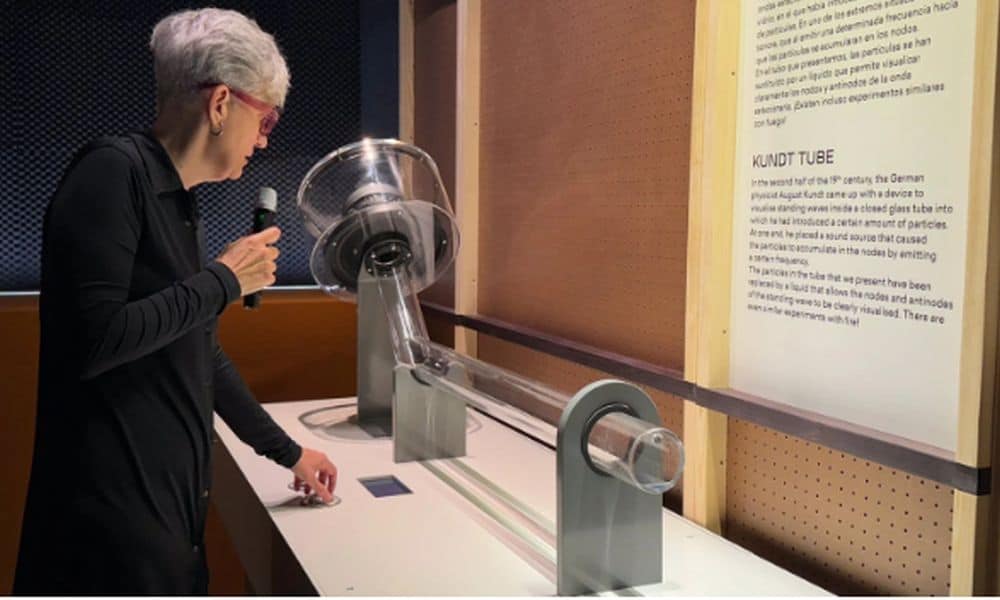
Public interaction
Valentí Farràs said at a press conference that it complements the CosmoCaixa experience because it encompasses the history researched about what sound is. In addition to how it propagates and human participation to transform it into music. It focuses on the interaction of the public, in making known a learning process that is easily understood by visitors. Also to show the public emblematic pieces about the study of sound.
Connection between music and mathematics: Music engages the audience through emotions.
On the other hand, the exhibition advisor and professor, Magda Polo, emphasizes that it is possible to see how music is capable of involving the public through emotions, as she points out the following: “because it has a fundamentally mathematical essence”. She also points out how mathematics allows us to understand the resources used in music.
Each note has a color due to its vibration
Approximately 300,000 visitors are expected to visit the exhibition for six months, equivalent to about 2,000 per day. Subsequently, it will move to Seville, Madrid, Valencia and Zaragoza, until 2026. It is an exhibition that is articulated on a scale of 7 concepts which is inspired by the 7 notes of the pentagram. Likewise, each one corresponds to a color. This is in line with the ideas of Aleksandr Skriabin shown in his symphony ‘Prometheus’ (1910), which stated that each note has a color by its vibration. It should be noted that the beginning of the exhibition, ‘0. That is, when it began was silence, which simulates the sound prior to the Big Bang. And the beginning of the functioning of the cosmos about how it began to function as sound machinery. In the next room, ‘0.00002. And much less, refers to the fact that 0.00002 pascals corresponds to the minimum volume of sound that people are able to hear, as if it were a grain of sand falling on a plate.
Space ‘1
In this space is measured emotion and beauty, where he explores how Pythagoras demonstrated the subdivisions of the 7 notes, plus you can see a replica of the monochord of Marin Mersenne of the seventeenth century. In the room ‘440, see the sound and feel the number comprises the representations of the sound to refer to the frequency of 440 hertz, this is the standard for perfecting string instruments.
Connection between music and mathematics: The ‘1607’ room
Here enters the theme of music, where its name is due to the year 1607, when it premiered ‘La fabula de Orfeo’ which was considered the first opera; and the space ‘100,000. This refers to the 100,000 beats of the human heart, also analyzes how the body, which “works as a polyphony.
Study of Johannes Kepler
In the last room, music divulger Carlos Calderón explains that the last room is ‘Infinity, the music of the spheres involves Johannes Kepler’s study of the sound of the planets, because he thought that there is something musical in the cosmos and that music is capable of analyzing the universe.
Complementary activities: Connection between music and mathematics
Complementary activities have also been organized so that children recognize what a sound wave is. They are complementary activities of such, family outreach activities workshops and scientific. In addition, it should be noted that the mathematician Laura Farrén will offer this Wednesday at the inaugural concert, which goes ‘From chaos to cosmos’. On the other hand, the professor of the University of Oxford (UK) will give a lecture on geometry in music. And the researcher of the Instituto de Astrofísica de Canarias (IAC) Terence John Mahoney and the filmmaker Juanma Betancourt will bring the music of the stars, with the documentary ‘The score of the cosmos’. In conclusion, the exhibition at Barcelona’s CosmoCaixa offers a fascinating exploration of the link between music and mathematics. Revealing how these two seemingly distinct fields are intrinsically related. Through various interactive activities and exhibits, visitors can appreciate the mathematics underlying music and how mathematical proportions, patterns and structures are fundamental to musical creation.



